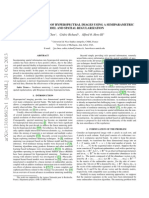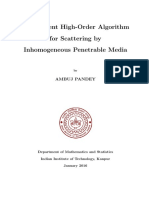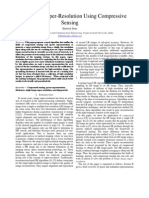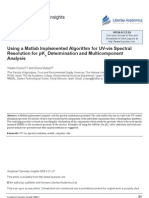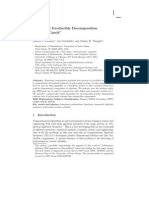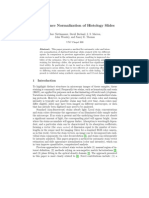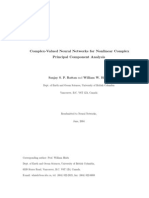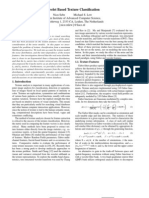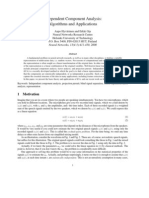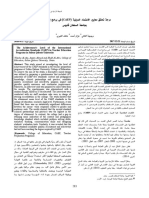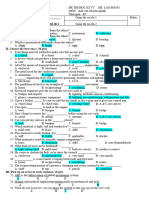Sparse Unmixing Analysis For Hyperspectral Imagery of Space Objects
Sparse Unmixing Analysis For Hyperspectral Imagery of Space Objects
Uploaded by
solmazbabakanCopyright:
Available Formats
Sparse Unmixing Analysis For Hyperspectral Imagery of Space Objects
Sparse Unmixing Analysis For Hyperspectral Imagery of Space Objects
Uploaded by
solmazbabakanOriginal Title
Copyright
Available Formats
Share this document
Did you find this document useful?
Is this content inappropriate?
Copyright:
Available Formats
Sparse Unmixing Analysis For Hyperspectral Imagery of Space Objects
Sparse Unmixing Analysis For Hyperspectral Imagery of Space Objects
Uploaded by
solmazbabakanCopyright:
Available Formats
Sparse unmixing analysis for hyperspectral imagery
of space objects
Zhenwei Shi
a
, Xinya Zhai
a
, Durengjan Borjigen
b
, Zhiguo Jiang
a
a
Image Processing Center, School of Astronautics, Beihang University, Beijing 100191, China
b
School of Mathematics and Systems Science, Beihang University, Beijing 100191, China
ABSTRACT
Spectral unmixing analysis for hyperspectral images aims at estimating the pure constituent materials (called
endmembers) in each mixed pixel and their corresponding fractional abundances. In this article, we use a
semi-supervised approach based on a large spectral database. It aims at finding the optimal subset of spectral signatures
in a large spectral library that can best model each mixed pixel in the scene and computes the fractional abundance which
every spectral signal corresponds to. We use
1 2
l l sparse regression technical which has the advantage of being
convex. Then we adopt split Bregman iteration algorithm to solve the problem. It converges quickly and the value of
regularization parameter could remain constant during iterations. Our experiments use simulated pure and mixed pixel
hyperspectral images of Hubble Space Telescope. The endmembers selected in the solution are the real materials
spectrums in the simulated data and the approximations of their corresponding fractional abundances are close to the true
situation. The results indicate the algorithm works well.
Key words: Sparse unmixing, space object, endmember, fractional abundance
1. INTRODUCTION
With more and more spacecrafts around the earth, its necessary for many countries to monitor them. Space remote
sensing imagery involves the acquisition of information from the spacecrafts surface without physical contact with the
area under study. Among the remote sensing modalities, hyperspectral imaging has recently emerged as a powerful
technology. The imaging spectrometer simultaneously scans the same surface scenery at dozens even hundreds spectral
bands
[1]
. Hyperspectral images contain rich spectral information to identify and recognize the materials. However, mixed
pixels are widespread in hyperspectral images, due to insufficient spatial resolution and unavailability of completely pure
spectral signatures in the scene. It becomes an obstacle to quantification analysis.
To deal with the mixture problem, linear spectral mixture analysis technique first identifies a collection of pure
constituent spectra in the literature
[2]
, and then expresses the measured spectrum of each mixed pixel as a linear
combination of endmembers weighted by fractions or abundances that indicate the proportion of each endmember
present in the pixel. Several hyperspectral unmixing methods have been proposed in recent years, which include
N-FINDR
[3]
, vertex component analysis
[4]
, independent component analysis
[5]
, the minimum volume enclosing simplex
algorithm
[6]
and flexible similarity measures
[7]
and nonnegative matrix factorization (NMF)
[8,9]
. All the algorithms above
can be separated into two categories: one is to select endmembers first and then solve the abundances; another is to solve
both endmembers and abundances directly from the data. They face the same two problems: one is how many
endmembers contained in the hyperspectral image, and the other is what kind of materials the endmembers are. It is
difficult to confirm the number of endmembers from the data itself. For the second problem, we can solve it to some
extent by measuring the similarity between endmembers and the spectrums of pure materials in spectral libraries. To
avoid the problems and simplify the unmixing process, we assume there is a large enough spectral library which contains
all the endmembers and other materials. In this paper, we adopt a semi-supervised approach using a spectral library to
solve the abundances of all the material in spectral database and to select endmembers automatically. To prove our
algorithm is efficient, we adopt simulated data whose endmembers and their fractional abundances we know in advance.
The structure of the paper is as follows: In Section 2 we establish the sparse unmixing model and then use split Bregman
iteration algorithm
[11]
to solve the problem in Section 3. At last we evaluate our method by experiments on both pure and
mixed pixel simulated hyperspectral images in Section 4 and close with conclusion in Section 5.
International Symposium on Photoelectronic Detection and Imaging 2011: Space Exploration Technologies
and Applications, edited by John C. Zarnecki, Carl A. Nardell, Rong Shu, Jianfeng Yang, Yunhua Zhang,
Proc. of SPIE Vol. 8196, 81960Y 2011 SPIE CCC code: 0277-786X/11/$18 doi: 10.1117/12.900271
Proc. of SPIE Vol. 8196 81960Y-1
Downloaded From: http://spiedigitallibrary.org/ on 03/31/2013 Terms of Use: http://spiedl.org/terms
2. SPARSE UNMIXING MODEL
Many algorithms use linear mixing model to solve unmixing problem. It corresponds to a reasonable balance between
accuracy and model complexity. It assumes that a spectrum from a given pixel is a linear combination of the spectra of
material present in the pixel. The coefficients are fractional abundances of corresponding spectrums. For each pixel, it
can be expressed as follows:
n Wh n w h v
i
P
i
i
+ = + =
=1
(1)
Where v is a 1 by L column vector (the measured spectrum of a pixel), L is the number of spectra bands, P is
the number of endmembers,
i
h is the fractional abundance of the
th
i endmember,
i
w is the spectrum of
th
i endmember, n is a 1 by L vector collecting the errors affecting the measurements at each spectral band. W is
a P by L endmember matrix, and h is a 1 by P vector of abundance.
The fractional abundances of the endmembers sum to one and can not be negative. These constrains are known as the
sum-to-one and the non-negativity constraints:
1
1
=
=
P
i
i
h (sum-to-one) (2)
i h
i
, 0 (non-negativity) (3)
We put pixels of all columns in a line. Then the hyperspectral data cube changes into 2-D matrix in which the column
represents spectra dimension and the row represents space dimension. The linear mixing model in the form of matrix is:
WH V = (4)
WhereV is a K by L matrix, and H is a K by P matrix. K is the number of pixels of hyperspectral image.
According to every row vector in H , we can get the distribution of each endmember in hyperspectral images.
Here, we use linear mixing model in a semi-supervised approach, where a matrix S containing many spectrums from
spectral library takes place ofW . It can be written as:
SH V = (5)
Where S is a Q by L spectra matrix, and H is a K by Q abundance matrix. Here, P Q > and L Q >> .
Thus, it has many solutions of H as it is an underdetermined system. As the number of pure materials containing in each
pixel is much less than in the spectral library, H is sparse. We can obtain a sparse unique solution using an efficient
sparse regression technique. A very simply and intuitive measure of sparsity of H is the
0
l norm
0
H which denotes
the number of nonzero components of the matrix .The sparse unmixing problem is:
V SH t s H
H
= . . min
0
(6)
The unconstrained minimization problem is:
+
0
2
2
2
1
min H SH V
H
(7)
This is a classical problem of combination search which sweeps exhaustively through all possible sparse subsets. The
complexity of exhaustive search is exponential in Q and it is NP-hard. The objective function is a non-convex, difficult
Proc. of SPIE Vol. 8196 81960Y-2
Downloaded From: http://spiedigitallibrary.org/ on 03/31/2013 Terms of Use: http://spiedl.org/terms
to solve. However, for the matrix S with certain properties of incoherence, the
0
l norm of sparse matrix H can be
replaced by the
1
l norm
1
H :
+
1
2
2
2
1
min H SH V
H
(8)
Here,
= =
=
q
i
K
j
j i
H H
1 1
,
1
.
It is a
1
l minimization problem and can be solved by some standard convex optimal algorithms. Here we use split
Bregman iteration.
3. SPLIT BREGMAN ITERATION ALGORITHM
Split Bregman iteration algorithm was first introduced by Goldstein and Osher for solving total variation (TV), compress
sensing and other regularized problems
[11]
. To solve the unconstrained sparse reconstruction problem, the iteration is
generated by using an auxiliary variable D and given by
H D t s D SH V
d H
= + . .
2
1
min
1
2
2
,
(9)
Convert it into an unconstrained problem:
2
2
2
2 1
,
2
1
2
min H D SH V D
d H
+ +
(10)
The regularized parameters , work as penalties balancing the energy functions. Optimization problem (10) is
performed in an alternating fashion:
+ =
+ =
+ + +
+ +
2
2
1 1
1
1
2
2
1
2
2
1
2
1
min arg
2
1
2
min arg
k k k
k k k
B H D D D
B H D SH V H
(11)
Where k denotes the iteration step.
In this fashion, we split the
1
l and
2
l components of minimization function.
k
B comes from adding back the error.
Then we can perform this minimization scheme as follows: initially set V V D B H = = = =
0 0 0 0
; 0 , and then update
the variables by iterations. The iteration is given as:
+ =
+ =
+ =
+ + =
+ +
+ + +
+ +
+
1 1
1 1 1
1 1
1 1
) 0 , max(
) ( ) (
k k k
k k k k
k k k
k k k T T k
SH V V V
D H B B
B H D
D B V S I S S H
(12)
Proc. of SPIE Vol. 8196 81960Y-3
Downloaded From: http://spiedigitallibrary.org/ on 03/31/2013 Terms of Use: http://spiedl.org/terms
As tol H H
k k
<
+
2
1
, where tol is the tolerance limit, the iteration stops. If the iteration stops with only few steps,
we use a fixed number of iterations. and are determined by the actual data. The experiments following show it is a
very efficient method for
1
l minimization.
4. EXPERIMENTS ON SIMULATED HYPERSPECTRAL IMAGES OF SPACE OBJECTS
For our numerical tests, we use the data developed by Zhang et al.
[12]
, where the authors constructed a dataset of
simulated data using a 3-D model of Hubble Space Telescope and a NASA library of material spectral signatures. The
simulated hyperspectral image consists of 8 materials which were assigned based on orientation of the Hubble telescope.
Their spectrums cover a band of spectrum from m 4 . 0 to m 5 . 2 for 100 evenly distributed sampling points,
leading to a hyperspectral data of size 193*177*100.
Figure 1 shows the first band hyperspectral image of Hubble Satellite Telescope. Figure 2 and Figure 3 show the spectral
signatures of 8 endmembers and their distributions in the image, respectively.
Figure 1. Simulated Hubble Satellite Telescope hyperspectral image of band 1
0 50 100
0.4
0.6
0.8
1
Bolts
0 50 100
0
0.5
1
Hubble Aluminum
0 50 100
0
0.5
1
Copper Strpping
0 50 100
0.2
0.4
0.6
0.8
1
Hubble Green Glue
0 50 100
0.7
0.8
0.9
1
Hubble Honeycomb Side
0 50 100
0.2
0.4
0.6
0.8
1
Hubble Honeycomb Top
0 50 100
0.4
0.6
0.8
1
Black Rubber Edge
0 50 100
0
0.5
1
Solar Cell
Figure 2. Spectral signatures of 8 pure materials designed in simulated data
Proc. of SPIE Vol. 8196 81960Y-4
Downloaded From: http://spiedigitallibrary.org/ on 03/31/2013 Terms of Use: http://spiedl.org/terms
Figure 3. Space distribution of 8 endmembers in simulated data
We designed the fractional abundances of 8 materials in every pixel, pure or mixed. By using the formula (5), the
simulated data is obtained.
The spectral library matrix S used in experiments was generated from USGS digital spectral library. We select 599
spectrums with 224 spectral bands distributed uniformly in the interval m 5 . 2 4 . 0 . Here we resample the spectra and
decrease spectral bands checking with spectrums of 8 component materials. Then spectral matrix S is
599 100 by size. Here we set
2
100
S S
T
= , and 05 . 0 = . We test our algorithm with pure and mixed pixel
simulated data.
4.1 Pure pixel hyperspectral images
In the pure simulated data, every pixel contains only one material at most, and the fractional abundances of all the pixels
are 0 or 1. The RMSE ( root mean square error) of the solution is
4
10 9 . 7
with 500 step iterations.
0.5 1 1.5 2 2.5 3
x 10
4
50
100
150
200
250
300
350
400
450
500
550
0
0.1
0.2
0.3
0.4
0.5
0.6
0.7
0.8
0.9
1
200 400 600 800 1000
2
4
6
8
10
12
14
0
0.1
0.2
0.3
0.4
0.5
0.6
0.7
0.8
0.9
1
(a) (b)
Figure 4. The sparse unmixing result of pure data (a) The solved fractional abundance matrix of the result valued by colors
(b) Details of the labeled region in (a).
Proc. of SPIE Vol. 8196 81960Y-5
Downloaded From: http://spiedigitallibrary.org/ on 03/31/2013 Terms of Use: http://spiedl.org/terms
Figure 5. Fractional abundances solved of 8 endmembers in pure data
Figure 4 illustrates the solution of our algorithm is sparse. In figure 5, we map the rows in abundance matrix whose
values are non-zero. Its clear that the solution is close to the true condition by comparing figure 3 and figure 5.
4.2 Mixed pixel hyperspectral images
We reduce the space resolution of the simulated hyperspectral image to a quarter of origin to create the mixed simulated
data. Each pixel consists of several materials whose fractional abundances sum to one. Its more complicated than pure
pixel condition and needs more iteration steps to converge. The result is that RMSE is 0.0013 with 500 iteration steps
and
4
10 15 . 6
with 1000 iteration steps. The same as figure 4, figure 6 shows fractional abundance matrix is sparse.
Figure 7 and figure 8 illustrate the solution closes to the fractional abundance designed.
0.5 1 1.5 2 2.5 3
x 10
4
50
100
150
200
250
300
350
400
450
500
550
0
0.1
0.2
0.3
0.4
0.5
0.6
0.7
0.8
0.9
1
200 400 600 800 1000
2
4
6
8
10
12
14
0
0.1
0.2
0.3
0.4
0.5
0.6
0.7
0.8
0.9
(a) b)
Figure 6. The sparse unmixing result of mixed data (a) The fractional abundance matrix of the result valued by colors
(b) Details of the labeled region in (a)
Figure 7. Fractional abundances designed of 8 endmembers in mixed data
Proc. of SPIE Vol. 8196 81960Y-6
Downloaded From: http://spiedigitallibrary.org/ on 03/31/2013 Terms of Use: http://spiedl.org/terms
Figure 8. Fractional abundances solved of 8 endmembers in mixed data
5. CONCLUSIONS
The paper introduces
1 2
l l
sparse regression technical to unmix hyperspectral images of space objects and applying
split Bregman method to solve the minimization problem. The experimented results show our algorithm succeeds in
solving fractional abundances in both pure and mixed simulated hyperspectral images and also it selects the true
endmembers from a large spectral library. The unmixing process is the procedure to identify the components of the
surface of space objects. We will have a further study on robust unmixing methods in the field of identification of space
objects.
ACKNOWLEDGMENTS
The work was supported by the National Natural Science Foundation of China under the Grants 60975003, the 973
Program under the Grant 2010CB327904, the Fundamental Research Funds for the Central Universities under the Grant
YWF-10-01-A10, and the Beijing Municipal Natural Science Foundation under the Grant 4112036.
REFERENCES
[1] Green R. O., Eastwood M. L., Sarture C. M., Chrien T. G., Aronsson M., Chippendale B. J., Faust J. A., Pavri B. E.,
Chovit C. J., and Solis M., Imaging spectroscopy and the airborne visible/infrared imaging spectrometer(AVIRIS),
Remote Sensing of Environment, 65(3),227248(1998).
[2] Plaza A., Martinez P., Perez R., and Plaza J., A quantitative and comparative analysis of endmember extraction
algorithms from hyperspectral data, IEEE Transactions on Geoscience and Remote Sensing, 42(3), 650663(2004).
[3] Winter M. E., N-FINDR: An algorithm for fast autonomous spectral end-member determination in hyperspectral
data, In Proc. SPIE Conf. Imaging Spectrometry V, 266275(1999).
[4] Nascimento J. M. P. and Dias J. M. B., Vertex component analysis: A fast algorithm to unmix hyperspectral data,
IEEE Transactions on Geoscience and Remote Sensing, 43(4): 898910(2005).
[5] Wang J. and Chang C. I., Applications of independent component analysis in endmember extraction and abundance
quantication for hyperspectral imagery, IEEE Transactions on Geoscience and Remote Sensing, 44(9): 26012616,
(2006).
[6] Chan T. H., Chi C. Y., Huang Y. M., and Ma W. K., A convex analysis-based minimum-volume enclosing simplex
algorithm for hyperspectral unmixing, IEEE Transactions on Geoscience and Remote Sensing, 47 (11):
44184432(2009).
Proc. of SPIE Vol. 8196 81960Y-7
Downloaded From: http://spiedigitallibrary.org/ on 03/31/2013 Terms of Use: http://spiedl.org/terms
[7] Chen J., Jia X., Yang W., and Matsushita B., Generalization of subpixel analysis for hyperspectral data with
exibility in spectral similarity measures, IEEE Transactions on Geoscience and Remote Sensing, 47(7):
21652171(2009).
[8] Paatero P. and Tapper U., Positive matrix factorization: an on-negative factor model with optimal utilization of error
estimates of data values, Environmetrics, 5:111126(1994).
[9] Lee D. D. and Seung H. S., Learning the parts of objects by non-negative matrix factorization, Nature,
401:788791(1999).
[10] Bruckstein A. M., Donoho D. L., and Elad M., From sparse solutions of systems of equations to sparse modeling of
signals and images, SIAM Review, 51:3481(2009).
[11] Goldstein T., and Osher S., The split Bregman method for l1 regularized problems, SIAM Journal on Imaging
Sciences, 2(2), 323-343(2009).
[12] Zhang Q., Wang H., Plemmons R., and Pauca P., Tensor Methods for Hyperspectral Data Analysis: A Space Object
Material Identification Study, Journal of the Optical Society of America, A., 25(12), 3001-3012(2008).
Proc. of SPIE Vol. 8196 81960Y-8
Downloaded From: http://spiedigitallibrary.org/ on 03/31/2013 Terms of Use: http://spiedl.org/terms
You might also like
- Stephanopoulos' Chemical Process Control - An Introduction To Theory & Practice - Solutions ManualDocument177 pagesStephanopoulos' Chemical Process Control - An Introduction To Theory & Practice - Solutions ManualShafi Marwat Khan100% (3)
- Mastering With Acustica 1.4Document125 pagesMastering With Acustica 1.4icanadaaNo ratings yet
- MT103Document1 pageMT103Ahmad Bhrn100% (1)
- Assignment On GoogleDocument6 pagesAssignment On GoogleHabib ZibranNo ratings yet
- Nonlinear Unmixing of Hyperspectral Images Using A Semiparametric Model and Spatial Regularization Jie Chen, C Edric Richard, Alfred O. Hero IIIDocument5 pagesNonlinear Unmixing of Hyperspectral Images Using A Semiparametric Model and Spatial Regularization Jie Chen, C Edric Richard, Alfred O. Hero IIIelahe92No ratings yet
- Wavelet Packets For Multi-And Hyper-Spectral ImageryDocument11 pagesWavelet Packets For Multi-And Hyper-Spectral Imageryakgulb35No ratings yet
- Forecasting Assignment2023Document3 pagesForecasting Assignment2023Laurie DevilersNo ratings yet
- An Efficient High-Order Algorithm For Scattering by Inhomogeneous Penetrable MediaDocument206 pagesAn Efficient High-Order Algorithm For Scattering by Inhomogeneous Penetrable MediaHari Madhavan Krishna KumarNo ratings yet
- Empirical Entropy Manipulation For Real-World ProblemsDocument7 pagesEmpirical Entropy Manipulation For Real-World Problemsminliang2kbjNo ratings yet
- Direction FindingDocument5 pagesDirection FindingOlariNo ratings yet
- Notes On Power Spectral Density (PSD) Estimation Using MatlabDocument10 pagesNotes On Power Spectral Density (PSD) Estimation Using MatlabPhilip Wang100% (1)
- Lukin Krylov Na So NovDocument4 pagesLukin Krylov Na So NovHoavo KhuyetNo ratings yet
- Image Deblurring and Super-Resolution by Adaptive Sparse Domain Selection and Adaptive RegularizationDocument35 pagesImage Deblurring and Super-Resolution by Adaptive Sparse Domain Selection and Adaptive RegularizationSiddhesh PawarNo ratings yet
- KarklinSimoncelli - NeurIps - 2011 - Efficient Coding of Natural Images With A Population of Noisy Linear-Nonlinear NeuronsDocument9 pagesKarklinSimoncelli - NeurIps - 2011 - Efficient Coding of Natural Images With A Population of Noisy Linear-Nonlinear NeuronsVyom RavalNo ratings yet
- Single Image Super-Resolution Using Compressive SensingDocument7 pagesSingle Image Super-Resolution Using Compressive SensingVassilis FotopoulosNo ratings yet
- Entropy Manipulation of Arbitrary Nonlinear MappingsDocument10 pagesEntropy Manipulation of Arbitrary Nonlinear Mappingsminliang2kbjNo ratings yet
- 2009 Good A New Quantum Edge Detection Algorithm For Medical Images 16438527Document7 pages2009 Good A New Quantum Edge Detection Algorithm For Medical Images 16438527Isram RasalNo ratings yet
- Breaking The Curse of Dimensionality With Convex Neural NetworksDocument53 pagesBreaking The Curse of Dimensionality With Convex Neural NetworksJonny BidonNo ratings yet
- Using A Matlab Implemented Algorithm For Uv-Vis SpectralDocument7 pagesUsing A Matlab Implemented Algorithm For Uv-Vis SpectralCesar FrancoNo ratings yet
- A Remote Sensing Image Fusion Algorithm Based On Nonnegative Ordinal Independent Component Analysis by Using Lagrange AlgorithmDocument4 pagesA Remote Sensing Image Fusion Algorithm Based On Nonnegative Ordinal Independent Component Analysis by Using Lagrange AlgorithmRajesh VeerabadranNo ratings yet
- Algorithms: Robust Hessian Locally Linear Embedding Techniques For High-Dimensional DataDocument21 pagesAlgorithms: Robust Hessian Locally Linear Embedding Techniques For High-Dimensional DataTerence DengNo ratings yet
- tmpD53B TMPDocument6 pagestmpD53B TMPFrontiersNo ratings yet
- Sample NewDocument6 pagesSample Neweasg130No ratings yet
- Isotropic Reconstruction of 3D Fluorescence Microscopy Images Using Convolutional Neural NetworksDocument9 pagesIsotropic Reconstruction of 3D Fluorescence Microscopy Images Using Convolutional Neural NetworksAdrian ShajkofciNo ratings yet
- Kernel Nearest-Neighbor AlgorithmDocument10 pagesKernel Nearest-Neighbor AlgorithmDebora OlivaresNo ratings yet
- Sparse Representation of Astronomical Images: Laura Rebollo-Neira and James BowleyDocument24 pagesSparse Representation of Astronomical Images: Laura Rebollo-Neira and James BowleyAyan SantraNo ratings yet
- Improved Approach For Mobile Robotics in Pattern Recognition 3DDocument8 pagesImproved Approach For Mobile Robotics in Pattern Recognition 3DSelva GanapathyNo ratings yet
- Liu 1995Document26 pagesLiu 1995ruohai372No ratings yet
- 1 s2.0 S1007570423003313 MainDocument26 pages1 s2.0 S1007570423003313 Mainaksharagate21No ratings yet
- Recognition of Temporal Sequences of Patterns Using State-Dependent SynapsesDocument18 pagesRecognition of Temporal Sequences of Patterns Using State-Dependent Synapsesyixinah516No ratings yet
- Radial Basis Function Networl (Wind Tunnel Wind Speed Detection Algorithm Based On PSODocument5 pagesRadial Basis Function Networl (Wind Tunnel Wind Speed Detection Algorithm Based On PSOبورنان محمدNo ratings yet
- Research Reports Mdh/Ima No. 2007-4, Issn 1404-4978: Date Key Words and PhrasesDocument16 pagesResearch Reports Mdh/Ima No. 2007-4, Issn 1404-4978: Date Key Words and PhrasesEduardo Salgado EnríquezNo ratings yet
- VRC Sketch Radiance Caching For Participating MediaDocument1 pageVRC Sketch Radiance Caching For Participating MediaPavol IľkoNo ratings yet
- Alexandridis 2015Document5 pagesAlexandridis 2015VicNo ratings yet
- 4.radial Basis Function NetworkDocument64 pages4.radial Basis Function NetworkAshna GautamNo ratings yet
- Color Image Enhancement Using A Retinex-Based Adaptive FilterDocument5 pagesColor Image Enhancement Using A Retinex-Based Adaptive FilterAbhishek KesharwaniNo ratings yet
- LR SurveyDocument24 pagesLR SurveyVanidevi ManiNo ratings yet
- An Improved Magnetic Localization and Orientation Algorithm For Wireless Capsule EndoscopeDocument4 pagesAn Improved Magnetic Localization and Orientation Algorithm For Wireless Capsule Endoscopesun liangNo ratings yet
- Liu 2017Document11 pagesLiu 2017Bhavatarini RaoNo ratings yet
- D14-07 TexteDocument40 pagesD14-07 TexteMedia KuliahNo ratings yet
- A Computationally Efficient Superresolution Image Reconstruction AlgorithmDocument11 pagesA Computationally Efficient Superresolution Image Reconstruction AlgorithmbinukirubaNo ratings yet
- Numerical Irreducible Decomposition Using PhcpackDocument20 pagesNumerical Irreducible Decomposition Using PhcpackNatasa BudisinNo ratings yet
- Niethammer2010 Color CorrectionDocument8 pagesNiethammer2010 Color CorrectionmarcniethammerNo ratings yet
- Jean Faber and Gilson A. Giraldi - Quantum Models For Artifcial Neural NetworkDocument8 pagesJean Faber and Gilson A. Giraldi - Quantum Models For Artifcial Neural Networkdcsi3No ratings yet
- Nonparametric_Wavelet_Regression_for_Binary_ResponDocument38 pagesNonparametric_Wavelet_Regression_for_Binary_ResponMuhammad ZulfadhliNo ratings yet
- Complex-Valued Neural Networks For Nonlinear Complex Principal Component AnalysisDocument21 pagesComplex-Valued Neural Networks For Nonlinear Complex Principal Component AnalysisJ Luis MlsNo ratings yet
- Matlab Phase RetrievalDocument9 pagesMatlab Phase Retrievalmaitham100No ratings yet
- A Particle Swarm Optimization For Solving NLP/MINLP Process Synthesis ProblemsDocument6 pagesA Particle Swarm Optimization For Solving NLP/MINLP Process Synthesis ProblemsAhmed WestministerNo ratings yet
- Importance Driven Path Tracing Using The Photon MapDocument11 pagesImportance Driven Path Tracing Using The Photon MapkfnepfkempNo ratings yet
- 1992.Angulo.X-Ray Tomography Applications in Porous Media EvaluationDocument11 pages1992.Angulo.X-Ray Tomography Applications in Porous Media EvaluationAlysson DiógenesNo ratings yet
- Wavelet Based Texture ClassificationDocument4 pagesWavelet Based Texture ClassificationSameera RoshanNo ratings yet
- Chapter-4 Principal Component Analysis-Based FusionDocument27 pagesChapter-4 Principal Component Analysis-Based FusionsumitmatheNo ratings yet
- J Chemolab 2018 07 008Document25 pagesJ Chemolab 2018 07 008Alejandro Romero ValenciaNo ratings yet
- 00384899fuzzy Fault in SensorsDocument6 pages00384899fuzzy Fault in SensorsIván VillamizarNo ratings yet
- WanZhen Liang Et Al - Fast Methods For Resumming Matrix Polynomials and Chebyshev Matrix PolynomialsDocument13 pagesWanZhen Liang Et Al - Fast Methods For Resumming Matrix Polynomials and Chebyshev Matrix PolynomialsPrem_SwiftNo ratings yet
- Regularized Compression of A Noisy Blurred ImageDocument13 pagesRegularized Compression of A Noisy Blurred ImageAnonymous lVQ83F8mCNo ratings yet
- ECL 222-A Numerical Methods-Day 1: Department of Physics, University of Colombo Electronics & Computing Laboratary IiDocument23 pagesECL 222-A Numerical Methods-Day 1: Department of Physics, University of Colombo Electronics & Computing Laboratary IiyasintharaNo ratings yet
- Ijecet: International Journal of Electronics and Communication Engineering & Technology (Ijecet)Document5 pagesIjecet: International Journal of Electronics and Communication Engineering & Technology (Ijecet)IAEME PublicationNo ratings yet
- AI Lab PracticalsDocument34 pagesAI Lab PracticalsHîмanî JayasNo ratings yet
- NIPS 2016 - blind regression - nonparametric regression for latent variable models via collaborative filtering PaperDocument9 pagesNIPS 2016 - blind regression - nonparametric regression for latent variable models via collaborative filtering Papergolgothgolgoth039No ratings yet
- Question Bank 3&4 Unit MLDocument6 pagesQuestion Bank 3&4 Unit MLjagadeeswaris.aiNo ratings yet
- Ashcim Ca01Document7 pagesAshcim Ca01Kien TranNo ratings yet
- Spline and Spline Wavelet Methods with Applications to Signal and Image Processing: Volume III: Selected TopicsFrom EverandSpline and Spline Wavelet Methods with Applications to Signal and Image Processing: Volume III: Selected TopicsNo ratings yet
- Sub-Pixel Mineral Mapping of A Porphyry Copper Belt Using EO-1 Hyperion DataDocument12 pagesSub-Pixel Mineral Mapping of A Porphyry Copper Belt Using EO-1 Hyperion DatasolmazbabakanNo ratings yet
- The Complete Encyclopedia of Minerals PDFDocument299 pagesThe Complete Encyclopedia of Minerals PDFjuanZaFNo ratings yet
- Book-A Exible Regression Approach Using GAMLSS in R.Document355 pagesBook-A Exible Regression Approach Using GAMLSS in R.solmazbabakanNo ratings yet
- Independent Component Analysis: Algorithms and ApplicationsDocument31 pagesIndependent Component Analysis: Algorithms and Applicationssolmazbabakan100% (1)
- Atmospherically Correcting Hyper Spectral DataDocument6 pagesAtmospherically Correcting Hyper Spectral DatasolmazbabakanNo ratings yet
- The Effect of Pressuremeter Geometry On The Results of Tests in ClayDocument11 pagesThe Effect of Pressuremeter Geometry On The Results of Tests in Claycepi herdiyanNo ratings yet
- Seminar On Teaching Syllabus BSED English 4ADocument7 pagesSeminar On Teaching Syllabus BSED English 4AMonica Benitez RicoNo ratings yet
- Lanre Aderemi CVDocument4 pagesLanre Aderemi CVLanreNo ratings yet
- Haghegh, M. (2021) Arabizi Across Three Different GenerationsDocument18 pagesHaghegh, M. (2021) Arabizi Across Three Different Generationsmariamhadi7No ratings yet
- HPD VeoliaDocument8 pagesHPD VeoliaalbidaiaNo ratings yet
- Action Research - Anne BurnsDocument19 pagesAction Research - Anne BurnssabdNo ratings yet
- Arabic Learnign EnglishDocument10 pagesArabic Learnign EnglishAngela DumitranNo ratings yet
- Wajeha Al-Ani, Azzam Ahmed and Khalf Al-Abri, College Of: Education, Sultan Qaboos University, OmanDocument18 pagesWajeha Al-Ani, Azzam Ahmed and Khalf Al-Abri, College Of: Education, Sultan Qaboos University, OmanSultan YousefNo ratings yet
- HLR Data BarringDocument2 pagesHLR Data BarringSamSamelevi100% (1)
- Final-Test Cdoto 16 Key PostedDocument9 pagesFinal-Test Cdoto 16 Key Postedtuan datNo ratings yet
- ICALL's Crowdsourced List of Mental Health Professionals We Can Trust (23rd April 2021)Document1,236 pagesICALL's Crowdsourced List of Mental Health Professionals We Can Trust (23rd April 2021)Sangana NevilonNo ratings yet
- Weekly Test Class 10Document4 pagesWeekly Test Class 10sweetyNo ratings yet
- TEKNIKDocument16 pagesTEKNIKMahwestie PwarnasoekmaNo ratings yet
- SPJ Manual PDFDocument128 pagesSPJ Manual PDFFreddy Jiron100% (1)
- Invoice Download 27527607 2014 10 13Document12 pagesInvoice Download 27527607 2014 10 13ShahChintanNo ratings yet
- AfsDocument10 pagesAfskdmillerNo ratings yet
- The Art of DeceptionDocument28 pagesThe Art of DeceptionCarl GroveNo ratings yet
- CollantDocument2 pagesCollantpogee752No ratings yet
- Cam and GrooveDocument4 pagesCam and GrooveEmnNo ratings yet
- Ksi KRR Operators ManualDocument69 pagesKsi KRR Operators ManualAeres707No ratings yet
- La Misma Luna: A Love Story With A Happy EndingDocument3 pagesLa Misma Luna: A Love Story With A Happy EndingNátasha FernándezNo ratings yet
- Continual Improvement ProcessDocument16 pagesContinual Improvement ProcessDayar e GairNo ratings yet
- Fatigue FailureDocument46 pagesFatigue FailureAhmad SalahNo ratings yet
- Iep Scavenger Hunt 1 PLC 2Document2 pagesIep Scavenger Hunt 1 PLC 2api-318038952No ratings yet
- Recruitment of Junior Management Trainee (Electrical) On Contractual BasisDocument10 pagesRecruitment of Junior Management Trainee (Electrical) On Contractual BasisAshirbad NayakNo ratings yet
- Symmetric Encryption Algorithms Provided by SunjceDocument13 pagesSymmetric Encryption Algorithms Provided by SunjcestefomarNo ratings yet




